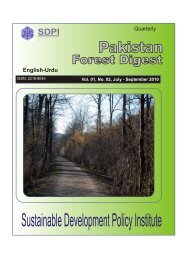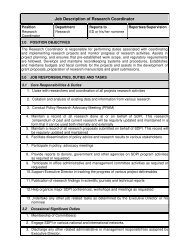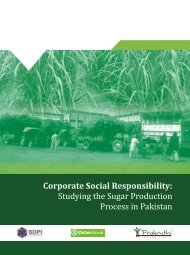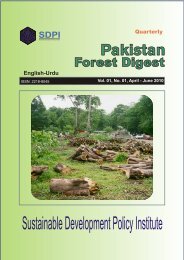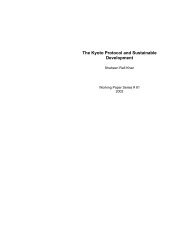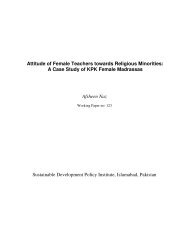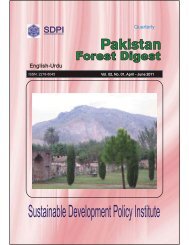Annual Report 2009-10 - Sustainable Development Policy Institute
Annual Report 2009-10 - Sustainable Development Policy Institute
Annual Report 2009-10 - Sustainable Development Policy Institute
- No tags were found...
You also want an ePaper? Increase the reach of your titles
YUMPU automatically turns print PDFs into web optimized ePapers that Google loves.
<strong>Annual</strong> <strong>Report</strong><strong>2009</strong> - 20<strong>10</strong><strong>Sustainable</strong> Industrial <strong>Development</strong>Balancing industrial growth with environmental sustainability is a huge challenge. <strong>Sustainable</strong>Industrial <strong>Development</strong> at SDPI has been engaged in policy research that may term industrialdevelopment environmentally friendly. Earlier researchers at SDPI developed “Self-Monitoringand <strong>Report</strong>ing Tool SMART” a software that is being used by the Environmental ProtectionAgency and industrial units in Pakistan for self-monitoring & reporting of chemical pollutants.This work was followed by Pakistan Environmental Program in the mid 2000s. More recently,SDPI is actively engaged not only in the identification of chemically polluted sites but also inremediation and reclamation of chemically contaminated sites. Much of this work is being carriedout in collaboration with the Swiss National Science Foundation & United Nations EnvironmentProgram (UNEP).Reclamation of Chemically Contaminated Sites in PakistanThe project is a joint research work carried out in collaboration with Agroscope ReckenholzTänikon Research Station ART, Zurich, Switzerland and Environmental Science Department,University of Peshawar, Pakistan, with financial support from Switzerland National ScienceFoundation (SNSF).Dichlorodiphenyltrichloroethane (DDT), a well-known insecticide, was produced from 1963 to1994 in a factory in Nowshera, Khyber Pakhtoon Khawa (former NWFP), Pakistan. The factorywas then closed and later on demolished. The production and distribution of the insecticide resultedin a DDT polluted area of about 85 ha. At the plant site, the soils contamination is up to5000 mg/kg DDT in dry soil. To reduce DDT exposure of the environment and humans, this contaminatedsite must be remediated. The main objective of this joint research project is to test aremediation strategy that substantially reduces the bio-available fraction of the aged DDT in thesoil. Efforts are underway to bind and immobilize the main contaminant, DDT and its metabolitesin the soil by activated charcoal (AC) amendment. AC has proven to significantly reduce the bioavailabilityof organic contaminants in solid matrices due to its high adsorption affinity, capacity,and strength. The novelty of this project is the application and thorough evaluation of this remediationtechnique to a field soil contaminated by sequestered DDT and metabolites.Specifically, in laboratory experiments with different soil contamination levels and different kindsof added AC (granulated AC (GAC), bio-char, and coke breeze as cheap and locally originatedmaterial), the bio-availability of DDT and metabolites has been assessed by depletive and nondepletive extraction methods. Preparations are underway for the 2nd phase of the project inwhich pilot field studies will be performed after the AC is added to the soil according to the initiallaboratory results. Overall, this technique presents, if successful, an economically sound, effectiveand feasible way to remediate organically contaminated hotspots in Pakistan and elsewhere.Preliminary laboratory scale experiments have shown a considerable reduction of DDT of thedesorbable fraction in the amended soil compared to the control soil. The reduction also showsthat this remediation technique works in principle. Yet, many questions concerning the behaviourof AC in the field remain open and need to be further investigated before this remediationtechnique can be put into practice, specifically with regard to different AC materials and varyingenvironmental factors like soil moisture and temperature.For further details contact Dr. Mahmood Khwaja. khwaja@sdpi.orgMapping of Chemical Contaminated Sites In PakistanSDPI inked a memorandum of understanding (MoU) with Blacksmith <strong>Institute</strong> (BSI), USA , forthe on-going Global Inventory Project (GIP) and is carrying out mapping of chemical contaminatedsites in Pakistan, to safeguard public health and environment in and around the pollutedsite area. Other partners in this joint project are the United Nations Industrial <strong>Development</strong> Or-19S u s t a I n a b l e D e v e l o p m e n t P o l I c y I n s t I t u t e



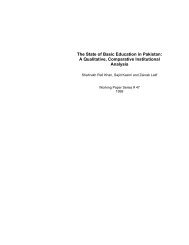
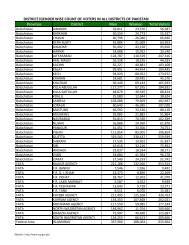
![(October - December, 2010) [13th SDC Special Bulletin]](https://img.yumpu.com/50118608/1/184x260/october-december-2010-13th-sdc-special-bulletin.jpg?quality=85)
